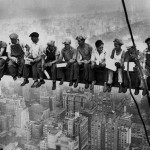 On January 21, 1930, in the middle of the world’s busiest city, excavation for New York’s Empire State Building began. 14 months later, on May 1 1931, the building was officially opened.
On January 21, 1930, in the middle of the world’s busiest city, excavation for New York’s Empire State Building began. 14 months later, on May 1 1931, the building was officially opened.
At 102 storeys it was for years the world’s tallest building. Around 21,000 people work there every day. It has a total floor area of 257,211 square metres. Each day’s work on the build produced 612 square metres of floor space. It cost, in today’s dollars, around $500 million or $1,944 per square metre.
In my quiet suburban street there is a house being built that has been under construction since the beginning of October 2009. For the past 28 months, six days a week, teams of carpenters, concretors and sundry tradesmen have been building a two-storey, detached house. With a floor area of around 200 square metres, it is not a mega-mansion. However more than $5 million dollars have already been spent on the build and its completion is still a long way off.
When the house is finally finished, each square metre of floor area will have cost around $27,500 and each day of its build will have produced a mere 0.9 square metres of floor space.
The house replaced a perfectly adequate brick bungalow, which was demolished and carted away. Then, before the build could even start in earnest, hundreds of cubic metres of sandstone bedrock were jack hammered out of the site to join the remains of the old house at the tip.
The house’s fashionable designer has called up only the best and most expensive materials and fittings and added to its complexity and expense with demanding and esoteric architectural details. Consequently the environmental
footprint of the house is massive. Its profligacy is clearly indicated in its square metre cost.
As well, the impact of the protracted build on the immediate neighbourhood has been much greater than that of a more moderate development. For almost two and a half years our narrow street has been crowded with tradies’ utes. Large mobile-cranes, skip-trucks, concrete mixers, earth-moving trucks and excavators regularly visit the building site and stay for hours. Street closures are common and there have been a number of accidents. Parking is a nightmare and walking can be dangerous.
All this aggravation and environmental degradation has been caused by one individual with more money than sense and a designer who has no regard for the environment. What can be done to curb these antisocial endeavours?
How about a profligacy tax on buildings that exceed a certain cost? And why not include a completion date in the Development Approval and penalise the building owner for every day that the build goes over that date?
Tony Coote

Leave A Comment